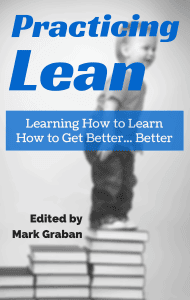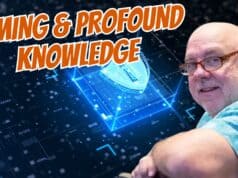 Today's post is an excerpt from the collaborative ebook project Practicing Lean. I wrote the first two chapters of the book and then asked others to contribute their early stories about mistakes and lessons learned.
Today's post is an excerpt from the collaborative ebook project Practicing Lean. I wrote the first two chapters of the book and then asked others to contribute their early stories about mistakes and lessons learned.
The first to take me up on this offer is Nick Ruhmann, who has an interesting story to share about starting with Six Sigma and then transitioning into Lean through his work with a Toyota supplier (under the direct tutelage of Jamie Bonini, the president of the TSSC).
I hope you'll consider buying the book. You'll get updates as new chapters are added and proceeds go to the Louise Batz Patient Safety Foundation. If you'd like to contribute a chapter, click here.
Think about Nick's story not just in the context of Six Sigma, but think about what happens when any methodology, including Lean, gets twisted as to be all about cost reduction. What happens when we ignore the lessons of Dr. W. Edwards Deming in the context of Lean or Six Sigma?
Nick's chapter, and again this is only an excerpt, includes some great lessons learned about the power of frontline staff ideas and engaging them instead of just flying experts around to fix things.
By Nick Ruhmann:
 Six Sigma was a big thing for us for several years… and I'd gotten pretty good at it. I managed to be the first in my class to get that coveted “Black Belt,” won our first “CEO” award for a project I led, and got to hob nob with folks in the company well above my real experience and grade level. Now to be fair, I wasn't nearly as arrogant as that might make me sound – or at least I hope not. Being a farm kid who was taught to respect my elders (regardless of my title) probably saved me a whole lot of headaches early on, and likely bought me some patience from those on whose shoulders I rode. But then again, I don't think it's ever possible to be too humble. Luckily, that viewpoint would serve me well later on, but I didn't know to what degree yet.
Six Sigma was a big thing for us for several years… and I'd gotten pretty good at it. I managed to be the first in my class to get that coveted “Black Belt,” won our first “CEO” award for a project I led, and got to hob nob with folks in the company well above my real experience and grade level. Now to be fair, I wasn't nearly as arrogant as that might make me sound – or at least I hope not. Being a farm kid who was taught to respect my elders (regardless of my title) probably saved me a whole lot of headaches early on, and likely bought me some patience from those on whose shoulders I rode. But then again, I don't think it's ever possible to be too humble. Luckily, that viewpoint would serve me well later on, but I didn't know to what degree yet.
After two or three years, the shine of the Six Sigma deployment had started to wear off. The company had trained about 100 of us “Black Belts,” maybe half of which had completed certification, but we had no strong sense from leadership regarding what we should be doing – other than saving money. Internally, a backlash grew against the new cadre of “experts”, fueled by special attention, bonus plans, and the confirmation of a rumor that the Black Belts were getting company cars.
![Week #6 Sport [6of52]](https://www.leanblog.org/wp-content/uploads/2015/09/week_6_sport_6of52-540x360.jpg)
Actually, no one ever took a car to my knowledge – the backlash from the rumor getting out kept that horse in the barn. But it was true, we were offered our choice of three different black convertibles, or a one time payout of $10K upon hitting a major cost savings target. Talk about breeding “elitism,” they were making it hard to be humble and not have it come across as a total act.
Cost reduction was the name of the game. So much so that, even after a bit of time, it pained me to see some using those fancy statistics to justify a cheaper supplier over the other, or a cheaper material over the other. These suppliers and materials were not on equal terms, but those making the choice played a game of “showing no difference” by selecting small numbers of parts. Sample sizes that weren't being contested, as there were attractive dollar signs associated with them. We soon outsourced part after part to lost cost suppliers in China, India, Mexico… all on a piece price savings basis.
Many times, engineers worried that switching suppliers might cause problems, but we had savings goals to hit. We'd pair suppliers against one another, find the “equivalent” part at the cheapest price and put in the change order. The OEM's were often happy to approve such changes, 5 cents per vehicle after all was 5 cents per vehicle. They had targets to hit too. Thankfully, years later we'd see nearly all these changes undone, as we'd finally do what W. Edwards Deming had been calling for the industry to do decades earlier. We'd eventually build long term relationships with select suppliers, often local suppliers. We'd even train them, work together on improvements, and let them keep the cost savings – knowing that a healthier supplier was a better partner for us in the long term. I'm happy to say that some of my students from that time include those from our supply base – suppliers still in use by the company today. But I digress; we weren't there yet.
A healthier approach was still years away. At this time, the pressure to deliver the almighty standard cost accounting dollar was king and a slight twinge of pessimism had started to creep into the ranks. Many of us thought – is this it? This can't last… this isn't making our company stronger for the long haul. This wasn't healthy cost reduction; it was cost cutting.
Bio: Nick Ruhmann is the Director of Operational Excellence for National Flood Services, a division of Aon plc – a leading global provider of risk management, insurance and reinsurance brokerage, and human resources solutions and outsourcing services.
Nick has been working in the insurance industry since 2012, however he began his career in manufacturing working for automotive supplier Tenneco Inc, and the medical technology company, Becton, Dickinson and Company (BD)
Nick has a B.S. in Mechanical Engineering from Southern Illinois University, lean manufacturing program certificate from the University of Michigan and a certification in “TRIZ” from the University of Kaiserslautern, Germany.
Nick and his wife currently reside in Montana with their two children. He can be found on Twitter as @Kaizen_Krazy.
What do you think? Please scroll down (or click) to post a comment. Or please share the post with your thoughts on LinkedIn – and follow me or connect with me there.
Did you like this post? Make sure you don't miss a post or podcast — Subscribe to get notified about posts via email daily or weekly.
Check out my latest book, The Mistakes That Make Us: Cultivating a Culture of Learning and Innovation:










Six Sigma is such a huge thing, but I guess if that’s your established process, you have to start there #LEAN.
This touches on the trap of using unit price as the primary decision point for selecting suppliers.
You’re right, Mark Edmondson. And, I think in part because getting to the lowest price bidder doesn’t take much effort. It’s the easy way out and buyers think they will get a gold star. And, they probably will! But, there will probably be a day of reckoning.
What you went through is probably not unusual. Lean and Six Sigma are often confounded, and this is perpetuated by consultants and some certificate programs (“LeanSixSigma”). Having been through this in a previous life, Six Sigma-as-mistakenly-executed fits the traditional management model better than real lean so is easier for senior leadership to understand and simpler to execute. Ironically, it can take some of the best problem solvers off the floor for BB and GB training and assign them to fix problems in non-constrained resources or attempt to reduce variation in unstable or non-capable processes. At some point the promised gains don’t materialize and the decision is made to put SS on hold and (hopefully) focus on removing waste and developing people.
[…] September, I posted an except from the first chapter by an outside contributor to the book, Nick […]